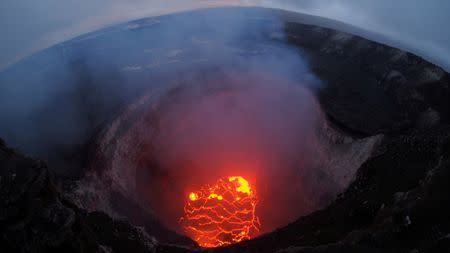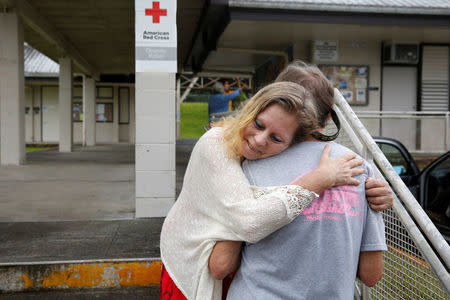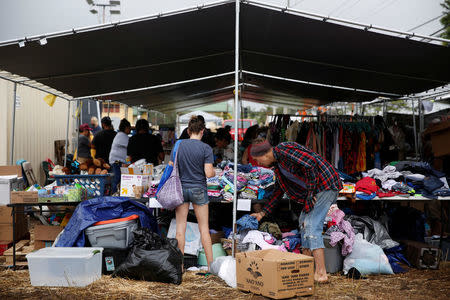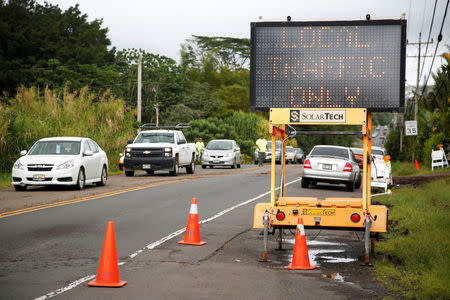Hawaii residents rue paradise built with 'lava discount'
By Terray Sylvester and Jolyn Rosa PAHOA, Hawaii/HONOLULU (Reuters) - Six days before Kilauea began erupting on Hawaii's Big Island, residents living under one of the world's most active volcanoes attended a community forum on preparing for emergencies. It was prompted in part by a mistaken alert in January that North Korea had launched a ballistic missile attack on Hawaii, which sent residents and tourists scrambling for shelter across the U.S. Pacific island state. Living in paradise comes with risks for the mostly retired residents in communities around Kilauea, who must also cope with the occasional hurricane - and the rumbling volcano proved the most damaging. "I knew I was getting the ‘lava discount,’” said Chris Foy, 40, who paid just $200,000 for his 1,900-square-foot (177-square-meter) house on a quarter acre (0.1 hectare) by one of the Big Island's best surfing beaches. Now he expects it is worth half that, a risk he knew he was taking and why he could buy his house in paradise so cheaply. Kilauea, one of five volcanoes on the Big Island, has been erupting nearly continuously since 1983. Residents are used to seeing the mountain belch smoke and ash and oozing lava from the summit. But what happened in the wee hours of last Friday was an unusual event. The floor of the crater collapsed and the lava flowed into a labyrinth of lava tunnels under the mountain, extending under the residential communities around Kilauea, the Jet Propulsion Laboratory at California Institute of Technology said on Monday. Fiery, demonic geysers of lava have been erupting in people's yards and on roads since then, forcing hundreds to evacuate. Hawaii state Representative Joy San Buenaventura, who represents a district by the volcano, led the April 28 forum on disaster preparedness in the Pahoa community center - now one of the main evacuation centers. "It was fortuitous that we had scheduled the forum, and I hope people took preparedness to heart," she told Reuters from Pahoa. "What we couldn’t prepare for was the amount and concentration of sulfur dioxide in the air." FIRE INSURANCE? Prevailing winds on Monday blew the sulfur clouds, which officials have described as "extremely toxic," away from the communities and out to sea. That allowed Keith Brock and some 600 others to go back to their homes to retrieve belongings. Brock arrived just in time to see his backyard erupt. "The sound was deafening, like 100 freight trains," he told Reuters TV. "Ground was bouncing up and down." "Last I heard, the house was gone," Brock said. "It's OK; things come and go." A real estate agent in Pahoa, Jessica Gauthier, said no company provides insurance covering lava damage, but homeowners could be covered by fire insurance. Hawaii Governor David Ige told a meeting at the Pahoa evacuation center on Monday that he has been pushing insurers to honor fire damage claims for homes destroyed in the eruption zone. The Hawaii Property Insurance Association issued a statement late on Monday saying it encouraged homeowners whose "properties were damaged or destroyed as a result of the lava flow to submit a claim as soon as possible." But residents said there is a lot of uncertainty around that as scientists say it is impossible to predict the duration of eruptions. Even after the eruptions end, it will take months for the ground to cool. Hawaii Civil Defense Administrator Talmadge Magno said late on Monday there is still plenty of magma under the ground. "If your house isn't lost, but you're not able to use it or live in it? There's so much uncertainty. That's the worst thing," said Audrey Meyer, 49, who worried it could be months before people are allowed back to their homes. Heide Austin, 77, a retired school teacher, only evacuated from Leilani Estates on Monday, after she heard the ground erupt near her home. "It sounded like a huge blowtorch going off." She had built a home and a small studio cabin on her six acres (2.4 hectares), growing her own food to eat. She has lived there since 1979 and seen many Kilauea eruptions, but never had to evacuate. "I knew that I was taking a chance building on this land, but I had no choice," she said. She cannot afford to buy a new home now if she has to abandon this one. "I'm thinking I'm going to have to find another job." (For a graphic on 'Scorched earth' click https://tmsnrt.rs/2IldVyS) (This version of the story fixes typos in first names "Audrey" and "Heide" in paragraphs 20 and 21) (Reporting by Terray Sylvester in Pahoa and Jolyn Rosa in Honolulu; writing by Bill Tarrant; editing by Jonathan Oatis)




